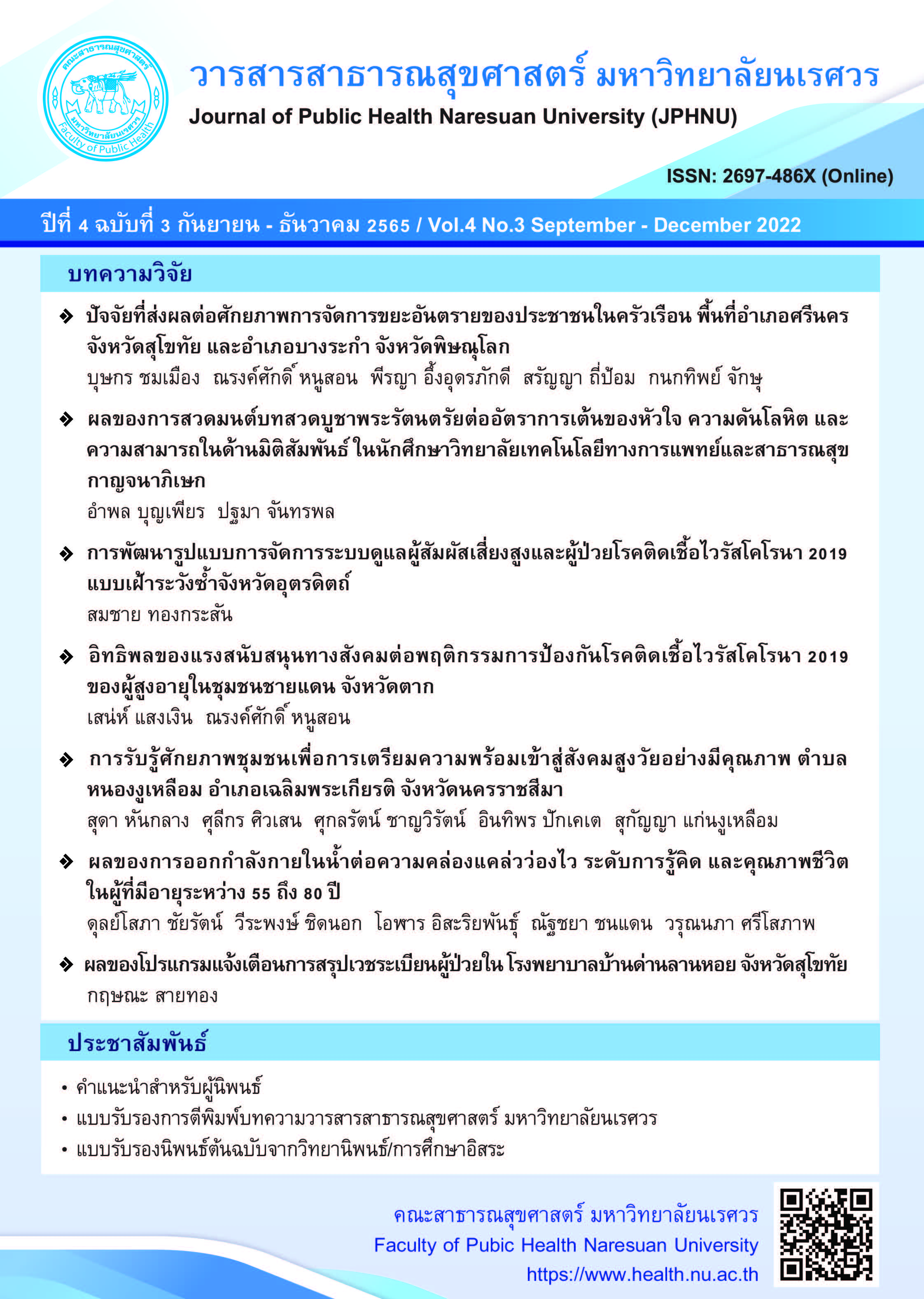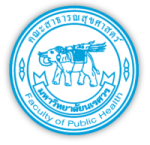Effects of aquatic exercise on agility, cognitive level, and quality of life in people aged between 55 to 80 years
Keywords:
Cognitive, Aquatic exercise, Agility, Quality of life, ElderlyAbstract
This quasi-experimental study aimed to investigate the effects of aquatic exercise on the agility, cognitive level, and quality of life of people aged between 55 and 80 years old. Thirty-two participants were recruited and divided into an experimental group (n = 17) and a control group (n = 15) using convenient sampling. Agility, cognitive level, and quality of life assessments of participants were performed, prior and post training, using the ten-step test (TST), Thai Mini-Mental State Examination 2002 (MMSE-Thai 2002), and EQ5D-5L, respectively. The experimental group received a 50-minute program of aquatic exercise, 2 times/week for 8 weeks while the control group continued their normal daily activities for 8 weeks. The differences within groups and between groups in TST, MMSE-Thai 2002, and EQ5D-5L scores were compared using the Wilcoxon Signed Rank test and the Mann-Whitney U test, respectively. A significance level of 0.05 was determined.
The results showed that the agility score after training in the experimental group was statistically higher than previous findings, and the experimental group score was higher than the control group (p-value < 0.001). However, the cognitive level and quality of life scores between the two groups showed no significant difference. The 50-minute aquatic exercise program failed to generate any serious adverse events, and all participants involved in the study completed the entire program. The aquatic exercise improved the agility of people aged between 55 to 80 years, but the improvements in their cognitive level and quality of life remained unchanged.
References
Andrew, M. K., & Rockwood, K. (2008). A five-point change in Modified Mini-Mental State Examination was clinically meaningful in community-dwelling elderly people. Journal of Clinical Epidemiology, 61(8), 827-831.
Ayan, C., & Cancela, J. M. (2012). Effects of aquatic exercise on persons with Parkinson's disease: A preliminary study. Science & Sports, 27(5), 300-304.
Cancela Carral, J. M., & Ayán Pérez, C. (2007). Effects of high-intensity combined training on women over 65. Gerontology, 53(6), 340-346.
Carral, J. M. C., Curras, D. M., Pérez, C. A., & Suárez, M. H. V. (2017). Effects of two programmes of combined land-based and water-based exercise on the cognitive function and fitness levels of healthy older adults. Motriz: Revista de Educação Física, 23(2), e101641. doi.org/10.1590/S1980-6574201700020011
Department of Elderly Affairs. (2020, March 7). Statistics of Thai Elderly. Retrieved October 10, 2021, from https://www.dop.go.th/th/know/side/1/1/335. (in Thai)
Department of Elderly Affairs Ministry of Social Development and Human Security. (2019). Measures to drive the National Agenda on Aging Society (2). Bangkok: Amarin Printing and Publishing Public Company Limited. (in Thai)
Devereux, K., Robertson, D., & Kathryn Briffa, N. (2005). Effects of a water-based program on women 65 years and over: A randomised controlled trial. Australian Journal of Physiotherapy, 51(2), 102-108.
Donath, L., van Dieën, J., & Faude, O. (2016). Exercise-based fall prevention in the elderly: What about agility? Sports Medicine, 46(2), 143-149.
Farinha, C., Teixeira, A. M., Serrano, J., Santos, H., Campos, M. J., Oliveiros, B. et al. (2021). Impact of different aquatic exercise programs on body composition, functional fitness and cognitive function of non-institutionalized elderly adults: A randomized controlled trial. International Journal of Environmental Research and Public health, 18(17), 8963. doi:10.3390/ijerph18178963
Foley, A., Halbert, J., Hewitt, T., & Crotty, M. (2003). Does hydrotherapy improve strength and physical function in patients with osteoarthritis - A randomised controlled trial comparing a gym based and a hydrotherapy based strengthening programme. Annals of the Rheumatic Diseases, 62(12), 1162-1167.
Fransen, M., Nairn, L., Winstanley, J., Lam, P., & Edmonds, J. (2007). Physical activity for osteoarthritis management: a randomized controlled clinical trial evaluating hydrotherapy or Tai Chi classes. Arthritis Rheum, 57(3), 407-414.
Fusco, O., Ferrini, A., Santoro, M., Lo Monaco, M. R., Gambassi, G., & Cesari, M. (2012). Physical function and perceived quality of life in older persons. Aging Clinical and Experimental Research, 24(1), 68-73.
Hojka, V., Stastny, P., Rehak, T., Gołas, A., Mostowik, A., Zawart, M. et al. (2016). A systematic review of the main factors that determine agility in sport using structural equation modeling. Journal of Human Kinetics, 52. doi:10.1515/hukin-2015-0199
Institute of Geriatric Medicine, DMS, MOPH, Thailand (2008, September). Medical technology assessment project. Retrieved October 1,2022, from http://agingthai.dms.go.th/agingthai/wp-content/uploads/2020/07/book_14.pdf.
Jafari, E., Sahebozamani, M., Beyranvand, R., Ebrahimipour, E., & Razavi, M. (2017). The effect of 8 weeks deep-aquatic exercises on static balance and lower body strength among elderly men. International Journal of Applied Exercise Physiology, 6(1), 86-98.
Janssen, M. F., Pickard, A. S., Golicki, D., Gudex, C., Niewada, M., Scalone, L. et al. (2013). Measurement properties of the EQ-5D-5L compared to the EQ-5D-3L across eight patient groups: A multi-country study. Quality of Life Research, 22(7), 1717-1727.
Kang, D. W., Bressel, E., & Kim, D. Y. (2020). Effects of aquatic exercise on insulin-like growth factor-1, brain-derived neurotrophic factor, vascular endothelial growth factor, and cognitive function in elderly women. Experimental Gerontology, 132, 110842. doi:10.1016/j.exger.2020.110842
Kim, S. B., & O'Sullivan D, M. (2013). Effects of aqua aerobic therapy exercise for older adults on muscular strength, agility and balance to prevent falling during gait. Journal of Physical Therapy Science, 25(8), 923-927.
Langa, K. M., & Levine, D. A. (2014). The diagnosis and management of mild cognitive impairment: A clinical review. Journal of the American Medical Association, 312(23), 2551-2561.
Lin, F. J., Pickard, A. S., Krishnan, J. A., Joo, M. J., Au, D. H., Carson, S. S. et al. (2014). Measuring health-related quality of life in chronic obstructive pulmonary disease: Properties of the EQ-5D-5L and PROMIS-43 short form. BMC Medical Research Methodology, 14(1), 78. doi:10.1186/1471-2288-14-78
Mandolesi, L., Polverino, A., Montuori, S., Foti, F., Ferraioli, G., Sorrentino, P. et al. (2018). Effects of physical exercise on cognitive functioning and wellbeing: Biological and Psychological Benefits. Frontiers in Psychology, 9, 1-10.
Martínez-Carbonell Guillamón, E., Burgess, L., Immins, T., Martínez-Almagro Andreo, A., & Wainwright, T. W. (2019). Does aquatic exercise improve commonly reported predisposing risk factors to falls within the elderly? A systematic review. BMC geriatrics, 19(1), 52. doi:10.1186/s12877-019-1065-7
Milanovic, Z., Pantelic, S., Trajkovic, N., Sporis, G., Kostic, R., & James, N. (2013). Age-related decrease in physical activity and functional fitness among elderly men and women. Clinical Intervention in Aging, 8, 549-556.
Miyamoto, K., Takebayashi, H., Takimoto, K., Miyamoto, S., Morioka, S., & Yagi, F. (2008). A new simple performance test focused on agility in elderly people: The Ten Step Test. Gerontology, 54(6), 365-372.
Nahand, M. S., Najafababdi, M. G., Naghdi, N., Sheikh, M., & Shaw, B. S. (2020). Effect of combined aquatic and cognitive training on quality of life, fall self-efficacy, and motor performance in aged with varying cognitive status: A proof-of-concept study. Journal of Exercise Rehabilitation, 16(2), 148-153.
Oh, S., Lim, J. M., Kim, Y., Kim, M., Song, W., & Yoon, B. (2015). Comparison of the effects of water and land-based exercises on the physical function and quality of life in community-dwelling elderly people with history of falling: A single-blind, randomized controlled trial. Archives of Gerontology and Geriatrics, 60(2), 288-293.
Orr, R. (2010). Contribution of muscle weakness to postural instability in the elderly. A systematic review. European Journal of Physical and Rehabilitation Medicine, 46(2), 183-220.
Prasad, L., Fredrick, J., & Aruna, R. (2021). The relationship between physical performance and quality of life and the level of physical activity among the elderly. Journal of Education and Health Promotion, 10, 68. doi:10.4103/jehp.jehp_421_20
Samadarshi, S. C. A., Taechaboonsermsak, P., Tipayamongkholgul, M., & Yodmai, K. (2021). Quality of life and associated factors amongst older adults in a remote community, Nepal. Journal of Health Research, 36(1), 56-67.
Seene, T., & Kaasik, P. (2012). Muscle weakness in the elderly: Role of sarcopenia, dynapenia, and possibilities for rehabilitation. European Review of Aging and Physical Activity, 9(2), 109-117.
Sherlock, L. A., Hornsby Jr, W. G., & Rye, J. (2013). Physiological effects of aquatic exercise on cognitive function in the aging population. International Journal of Aquatic Research and Education, 7(3), 9. doi.org/10.25035/ijare.07.03.09
Singh, D. K., Pillai, S. G., Tan, S. T., Tai, C. C., & Shahar, S. (2015). Association between physiological falls risk and physical performance tests among community-dwelling older adults. Clinical Interventions in Aging, 10, 1319-1326.
Strategy and Planning Division. (2020, October 29). Death certificate. Retrieved October 1, 2022, from https://bit.ly/3rKRvMx. (in Thai)
Svraka, E., Pecar, M., Jaganjac, A., Hadziomerovic, A. M., Kaljic, E., & Kovacevic, A. (2017). Physical therapy in elderly suffering from degenerative diseases. Materia Socio-Medica, 29(4), 272-275.
Unai, K., Sucamvang, K., Henkaew, W., Norkam, R., & Pinijsuwan, N. (2017). Mental status and health promoting behaviors among older persons in Pa-aordonchai Subdistrict Municipality. Nursing Journal, 44(Suppl. 2), 1-11. (in Thai)
Whitehead, A. L., Julious, S. A., Cooper, C. L., & Campbell, M. J. (2016). Estimating the sample size for a pilot randomised trial to minimise the overall trial sample size for the external pilot and main trial for a continuous outcome variable. Statistical Methods in Medical Research, 25(3), 1057-1073.
World Health Organization. (2021, April 26). Falls. Retrieved October 1, 2022, from https://www.who.int/news-room/fact-sheets/detail/falls.
Zhang, W., Low, L. F., Schwenk, M., Mills, N., Gwynn, J. D., & Clemson, L. (2019). Review of gait, cognition, and fall risks with implications for fall prevention in older adults with dementia. Dementia and Geriatric Cognitive Disorders, 48(1-2), 17-29.
Downloads
Published
How to Cite
Issue
Section
License
Copyright (c) 2022 Journal of Public Health Naresuan University

This work is licensed under a Creative Commons Attribution-NonCommercial-NoDerivatives 4.0 International License.
The published article is copyrighted by the Journal of Public Health and Health Sciences Research.
The statements that appear in each article in this academic and research journal are the personal opinions of each author and are not related to Naresuan University and other faculty members in the university. Responsibilities regarding each article are the responsibility of each author.






